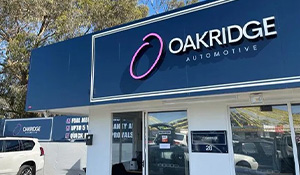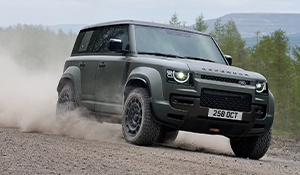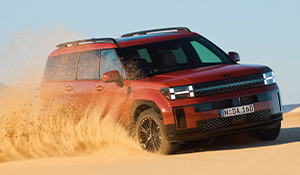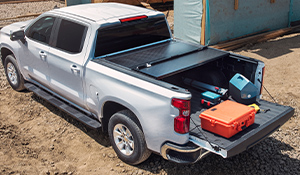Review – LandCruiser 79 Series Double Cab GXL
The LC70 can just about trace its ancestry all the way back to the Toyota BJ of the 1950s. While there used to be only one LandCruiser, the line split in the late 1960s via the J50 station wagon body, which developed into the LandCruiser 60 Series, 80 Series, 100 Series and today’s 200 Series. The LC70, however, has remained faithful to the original design from the 1950s.

What is the LandCruiser 79 Series?
Up until this current iteration, the basic layout of 4.5-litre V8 diesel with a part-time 4X4 system and live axles was maintained, but key changes for 2016 included the addition of cruise control; taller second- and fifth-gears, by 7% and 15% which contribute to fuel saving; electronic driving aids – traction control and stability control, with advanced ABS (brake distribution and brake force assist), hill start assist; five-star safety on the single cab only – airbags, strengthening, steering link relocation; a diesel particulate filter (DPF), other changes to make it Euro 5 emissions compliant; engine upgrades that are claimed to improve fuel consumption by 10.1%; changing the split-rim steel rims to one-piece with tubeless tyres (Workmate, our tester is a GXL with alloys); a single 130L tank, except for the Troopy which retains two 90L tanks; auto locking front hubs instead of manuals; front seatbelt pre-tensioners; engine immobilizer; a new infotainment unit with Bluetooth and MP3 CD player.

What’s the interior of the LandCruiser 79 Series like?
Basic is the operative word here. The heating and cooling controls are not touchscreen (good) or even dials, they’re 1980s spec levers. There is one interior light and that’s in the middle. Seating adjustment is simple with just fore, aft and recline. There is no mirror in the sun visor.
The dashboard is basic too. There’s no temperature or fuel consumption display, but you do get a DPF gauge. And yes, those heating controls are out of a 1980s Corolla. They still work though. Below the air-con is an actual electric antenna that extends and retracts when the radio is switched on, or you can do it manually.

There is no courtesy delay light and certainly no puddle lamps. No steering wheel controls. No split aircon. You know all those little modern touches on modern cars? Forget it. However, there is Bluetooth, which works quite well even at 100km/h, and remote central locking. The blue-grey interior colour scheme is straight from the 1980s and won’t be to everyone’s taste.
The infotainment unit offers a CD player, USB port, aux-in, Bluetooth, AM/FM and has buttons not a touch-screen which is a positive. It is a decent unit for the vehicle, but there are no modern features, like Apple CarPlay or Android Auto connectivity but then Toyota doesn’t offer that on any of its vehicles.

In the back, the rear seats fold forwards and down. There is room to store some gear behind the seats, or they could be removed entirely. Toyota also provides a decent bottle jack.
The LC79 comes as a cab chassis with optional tray which has been fitted to our test vehicle, plus a dual battery install. Our tester also had access ladders and steps. The snorkel is standard.
The tray is decent. It looks to be well made, and there’s good tie-downs on the bed which are recessed into the floor. The dimensions are 1840mm width and 1800mm length. The sides fold down and can be removed, and there are tie-down rails along the sides. LC70 utes must be optioned with trays, or choose an aftermarket unit.
Overall, think of 1990s design and 1980s features… that’s the LC79. Now that sounds like a terrible thing to say, but in fact it’s not that bad. Everything is easy to use because it’s all buttons, levers and dials, no touch screens, there’s space to bolt your own things in like extra drinks holders, and it’s all easy to use. Plus, there is a certain charm to the simplicity of the design which is refreshing. You’d want to customise it a bit, but the LC79’s interior does lend itself to practical if not comfortable off-roading.

What’s the LandCruiser 79 Series got?
Not a lot of advanced tech here. There’s a part-time 4x4 system now with manually lockable or automatic locking hubs. The transfer case offers 2WD (2H), 4WD high (4H) and 4WD low range (4Lo). You can shift from 2H to 4H at speed, although our 79 wasn’t very keen on the operation. You can even shift from 4Lo to 4H at speed too.
Electronic driving aids are new to the LC70. Here’s a rundown:
- VSC – Vehicle Stability Control, otherwise known as ESC.
- A-TRC – Brake Traction Control.
- TRC – Engine Traction Control.
- ABS – Antilock Braking System.
- Brake Assist – detects an emergency stop and increases brake pressure.
- EBD – Electronic Brakeforce Distribution.
- Hill Start Assist.

What’s the LandCruiser 79 Series like to drive?
The LC79 is no corner carver, more a chainsaw than a scalpel. Let’s start with the good, which is visibility. As the car is so old you sit high with an upright windscreen and small A-pillars, so you can see everything.
The LC79’s traction is also surprisingly good, even in the wet. I think that’s because of the lazy-revving engine with low-down torque, so I drove it relying on the torque in higher gears rather than using lots of revs.
On the negative side, the engine is noisy, as are the gears especially in lower ratios. With the taller fifth-gear you’re now at 2000rpm at 100km/h, which is still at least 300rpm too high and you do miss a sixth gear. There’s lots of wind noise. Directional stability is not great. The turning circle is a huge 14.4m and the steering is slow. The steering is reach and tilt adjustable, but many drivers will find their knees uncomfortably close to the steering column which is at least height/reach adjustable. The wing mirrors are not electric and jiggle a bit on the move.
The cruise control does work well, and I had to smile when I saw it’s the same switch as fitted in the Lexus RC F. Parts sharing extends beyond the head unit.
The engine works well from about 700rpm which is good, but just converts diesel to noise above 3000rpm and to the 4500rpm redline, so you’re better off swapping cogs before 2500rpm. First gear is so low it’s not worth using to pull away unloaded, just start in second-gear and use the long-throw, slow gearshift to jump directly to fourth. At least with skip-shifting you don’t need many gear changes.
I daily-drove the 79 in traffic for a while and thought it was livable. Just drive to the strengths of the car – torque, visibility – and it’s all good. For a leaf-spring rear end the flex is good too, although after 9000km our test car did look a little saggy in the back. The factory sidesteps are high up, and the 44:1 crawl ratio is nicely low. You can often just let the car idle along in first-gear low with your feet off pedals.

Then there’s the cross-axle differential locks, standard on GXLs. Once locked these give the 79 a huge degree of off-road capability, but they’re not perfect. The rear comes in quickly, but there’s a delay on the front, and both can take a while to disengage.
For the 2016 models onwards there’s a new style of locking hub and this isn’t an improvement as it removes the ability to drive in low-range in 2WD, or isolate the front drivetrain in the event of failure. However, it works well for a locking hub, keeping the vehicle in 4WD even with back-forth movements. For tough going it would still be a good idea to lock them manually rather than relying on the automatic facility though.
There is now brake traction control, which Toyota calls Active TRC. This works well, to a point, then gives up... It is nowhere near as effective as the same system on Prado, Fortuner, HiLux or LC200. It’s like Toyota’s engineers spent half a day on it and then went home. Maybe they thought the diff locks would do the job instead. To some extent they’re right, but the LC79’s traction control calibration is definitely below-par and not up to Toyota’s standards. It should be much better, and properly complement the cross-axle lockers. But the real negative is that the LC79 is also prone to getting hung up on those massive leaf springs which are underslung the axle.
Overall, the LC79 is a very capable off-road machine, mostly thanks to its twin lockers.

What safety features does the LandCruiser 79 Series get?
Only the single-cab 79 is rated five-stars by ANCAP. There’s no ANCAP rating for any others, but as the single cab prior to the 2016 safety upgrades rated three stars in 2010 through to 2015 it’s fair to assume the non-single cabs would be around the same in 2017. The non-single cabs miss out on several safety features such as extra airbags, steering link relocation, more rigid frame and height-adjustable seating. However, all models now have pre-tensioning seatbelts and seatbelt warnings. The rear centre seatbelt in the dual-cab is only a lap belt not a two-point shoulder belt. There are no child restraints but there are aftermarket solutions. The electronic safety solutions for the MY2016 models are stability control and advanced ABS – electronic brake distribution and electronic brake assist. There is no reversing camera, and the vehicle needs one.

So, why would you buy a LandCruiser 79 Series?
To buy an LC79 dual-cab GXL you’ll need $68,990+ORC for the vehicle, $2761 for the air-con which is ridiculous in this day and age, and anywhere between $5000 and $15,000 for the service body, as a basic tray isn’t going to suit off-roading. In other words, the vehicle is about $71,500 plus on-roads, followed by more money to do something with the back.
The basic LC79 costs more than a Ranger PX2 Wildtrak (about $65k drive-away), and way more than a HiLux SR5 ($62k drive-away). And, into the bargain you get a five-speed manual with an old engine, poor fuel economy, questionable safety, a dated interior, very few convenience features, not even world-class off-road capability, and Toyota couldn’t even be bothered to make the front and rear axles the same track or fit proper interior lights. In fact, they have done the bare minimum to keep the vehicle alive.
So why on earth would anyone bother with the LC70? Because it is the most reliable outback heavy-duty workhorse ute you can buy, bar none.
The design is old, but because of that it’s been proven, proven and proven again. Toyota knows how to build reliable off-roaders. The live axles, leaf springs and part-time 4WD system are all old, but simple and reliable. Toyota said in its press release that, “We have also checked the diesel particulate filter is well protected and we found there are no issues for it or the new piezo injectors resulting from local fuel in the outback” which are words you want to hear and won’t find in any other off-road oriented vehicle’s press release.
And that there is your reason to buy an LC79, if you prize dependable reliability and ability to get the hard jobs done above all else – above things like comfort, safety and convenience. And many of the features the LC70 is missing can be added easily enough, for example reversing cameras, interior lights, better seats. It’s harder to engineer in basic load-carrying reliability.
2017 TOYOTA LANDCRUISER LC79 DUAL CAB GXL
Pricing: $68,990 plus onroad costs (Price As Tested Air Conditioning: $2,761.00; Metallic Paint: $550.00; Colour-coded Steel Tray with chequer plate floor: $4,025; Ladder: $499.97; Towbar: $627.00; Tow ball: $31.24; Lower Toolbox: $546.00; Trailer Wiring Harness: $234.00; Head Board Spare Tyre Hanger: $134.90 TOTAL: $78,399.11)
Warranty: three-years, 100,000 kilometres
Safety: Unrated (single cab only 5 star rating for 2015)
Engine: 4.5 litre V8 turbo-diesel
Power: 151kW at 3400rpm
Torque: 430Nm at 1200rpm
Transmission: five-speed manual
Drive: part-time 4X4, low range, front and rear locking differentials
Dimensions: 5230mm (L); 1870mm (W); 1955mm (H)
Ground clearance: 232mm
Approach/ramp/departure angles: 33 / not available / 27 degrees
Wading: 700mm
Seats: five
Turning circle: 14.4m
Tare weight: 2175kg
GVM: 3300kg
Fuel Tank: 130 litres
Thirst: 10.7L/100km
Fuel: diesel
Towing: 3500kg braked, 350kg TBM, 750kg unbraked
GCM: 6800kg
Spare: full-size alloy underslung









